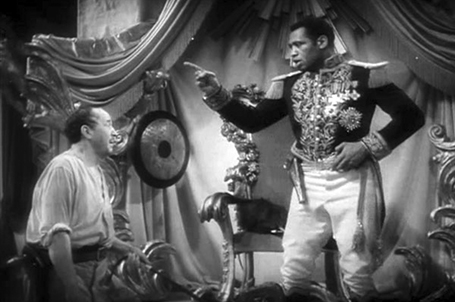Tuesday, Feb 25, 2014
The two-day event examines the interplay of plays, musicals and movies
by Adam Grybowski
Despite tackling challenging and often bleak themes, playwright Eugene O'Neill earned critical and commercial success in the first half of the 20th century. The popularity of his plays made movie producers and directors eager to get their hands on his scripts and adapt them for the big screen.
O’Neill mainly expressed discomfort with the results, alongside occasional approval. “He was not a movie guy,” says Gary Vena, a professor of theater history and dramatic literature at The New School in New York City. “His life was the theater.”
Vena will appear as a feature speaker at Rider University’s Broadwaywood: Intersections of Stage and Screen, the 2014 Film and Media Studies/Cinema Studies Symposium on March 5 and 6. The two-day event features several movie screenings, student and faculty presentations, and roundtable discussions examining the interplay of plays, musical and movies. Screenwriter William Mastrosimone ‘74 will also give a presentation on his experience working in theater and film, and students will receive awards for their screenplays, movies and papers during a mini-film festival within the symposium.
“One of the goals of the symposium is to create a film culture on campus,” says film and media studies program director Cynthia Lucia. “We want students to embrace film not just as a mindless form of entertainment, but something to devote serious thought to.”
Held each March and now in its sixth year, the event has examined different genres, directors and social forces that affect the movies. This year’s theme, which students picked, is ripe for examination. The cross-pollination of forms (plays become movies, movies become plays, documentaries become musicals, and on and on) encourage artistic possibility and can produce diverging results based on the same material.
That shouldn’t come as a surprise, Lucia says, because screen and stage differ in fundamental ways. Theater locks its audience into one position in relationship to the action on stage, whereas film is constantly altering the viewer’s position through cuts. Stage actors are aware of the audience, but film actors never see them. Theater is predominantly a verbal medium and film a visual one.
“I wouldn’t say one is superior to the other,” says Lucia, who will contribute to a presentation looking at the screen and stage versions of A Streetcar Named Desire, which both starred Marlon Brando and were directed by Elia Kazan.
Many adaptations, like those of O’Neill’s plays, enjoy separate lives, with the stage and screen versions reaching two audiences and becoming, in a sense, two distinct products. O’Neill’s 1923 play, Strange Interlude, which won the Pulitzer Prize, was adapted into a 1932 movie starring Norma Shearer and Clark Gable. On stage, it runs for more than four hours during nine acts. The movie cuts the length to 90 minutes.
“You can imagine how this play, which dared to portray the inner thoughts of characters and featured an incredible theatricality, was totally reduced on screen,” says Vena, was a guest at the Nobel Symposium in Stockholm for the Eugene O’Neill Centennial. “That was upsetting to O’Neill.”
On the other hand, the 1973 adaptation of The Iceman Cometh starring Lee Marvin cuts some of the text, but “you hardly notice what’s been removed,” says Vena, who wrote a book on the play’s 1946 premiere. “I think that was a beautiful translation to the screen.”
Long Voyage Home wraps four early O’Neill plays into one feature-length movie starring John Wayne. “It’s magically done and a moving experience. He had a lot of respect for what Hollywood did with that,” Vena says of O’Neill’s attitude toward the movie, which was directed by John Ford. “He was in good hands.”
Two movies that reworked O’Neill’s scripts for the screen, Desire Under the Elms starring Sophia Loren and The Emperor Jones starring Paul Robeson, will be screened during the symposium. They help to prove how much actors benefitted from having adaptations of O’Neill to work with, Vena says. Still, despite attracting talented actors, O’Neill was often “uncomfortable with watching his plays on stage and certainly the films that came out of them,” Vena says. “I think he had a lot of trouble liking actors.”
The work of Mastrosimone, a Trenton native who has written several plays and screenplays, will anchor the symposium’s second day. Mastrosimone earned his master’s degree in playwriting from the Rutgers University Mason Gross School of the Arts after graduating from Rider in 1974. He adapted his own 1982 off-Broadway play, Extremities, into a 1986 movie, which will be screened before his talk. It stars Farrah Fawcett and James Russo, both of whom appeared in the play.
Student interest in the intersection of screen and stage surprised Lucia. “We talked through different topics and this is the one they really wanted,” she says, pointing to the University’s thriving theater program as a probable source of the enthusiasm. “So many of our students are serious literary students who love Tennessee Williams and other playwrights. They’re exposed to theater in a concerted way.”
Of all the symposiums, this one has been the most challenging to put together, Lucia says. “There are so many theatrical genres that something will unfortunately get short shrift,” she says. Nonetheless, the symposium achieves her goal of exposing students to film scholars like Vena and professionals like Mastrosimone. “Beyond that,” she says, “we see it as a valuable way to bring students and faculty together to create a collaborative learning community.”
A full schedule of events will be posted at www.rider.edu/fms.

